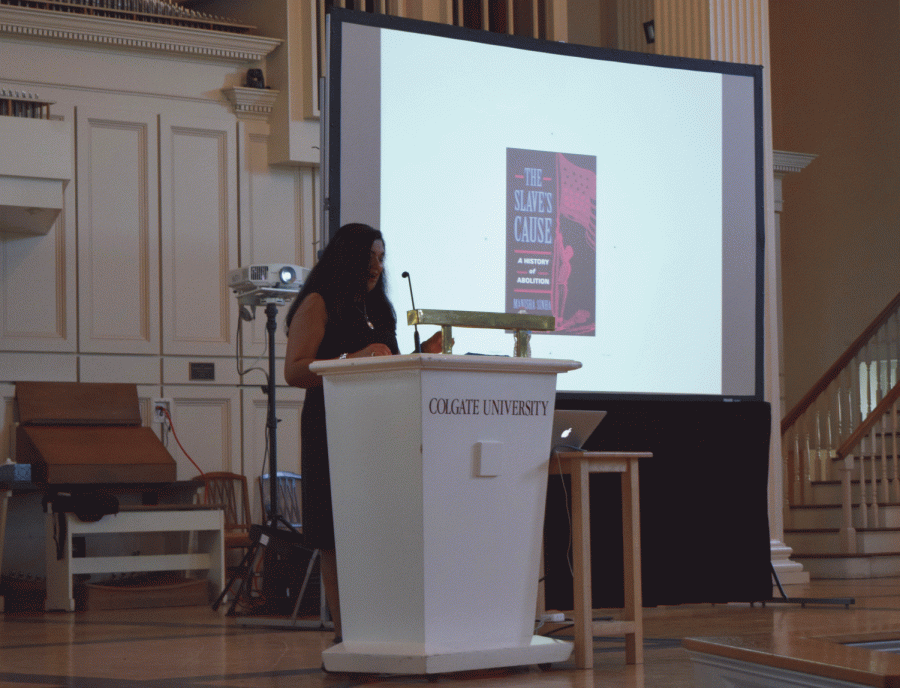Sinha Lectures on a New History of Abolition
Professor Manisha Sinha, pictured above, lectured on the abolitionist movement. Sinha highlighted the role of slave resistance in abolition.
On Monday, September 25, Professor Manisha Sinha gave a talk on the abolitionist movement. Sinha is the Draper Chair of History at the University of Connecticut. Her main research interest lies in early American and African American histories, especially the transnational histories of slavery and abolition and the history of the Civil War and Reconstruction. Her talk was centered on her recently published book, The Slave’s Cause: A History of Abolition.
At the beginning of the lecture, Sinha made clear that her book highlighted the dimension of social movements. The social movements explored in her book were radical, interracial and transnational. There were two main arguments in her book. First, she extended the chronology of the abolitionist movement from the Civil War and Reconstruction back to the American Revolution. Second, she emphasized the agency of the slaves and the importance of slave resistance.
Sinha emphasized her rejection of the conventional division between the anti-slavery movement and slave resistance. Movement, defined as “a group of people working together to advance their shared political, social or artistic belief,” has a connotation of agency. By drawing a neat line between the anti-slavery movement and slave resistance, with the anti-slavery movement associated mainly with the white middle-class, we deprive the slaves of their ability to make change. But slaves themselves did bring significant change.
The Haitian Revolution from 1791 to 1804, for example, radicalized the abolitionist movements. The fact that black and brown people could overthrow the colonial government and establish a nation of their own inspired abolitionists overseas. More radical abolitionists, such as Elizabeth Heyrick and David Walker, emerged. Both advocated for immediate abolition.
Similarly, nothing brought abolitionists together as much as the fugitive slaves. The runaway slaves, many of whom wrote about their suffering, created a “genre” of fugitive slave narratives that were not only powerful in themselves but also gave rise to some prominent white abolitionist voices. Harriet Beecher Stowe, who wrote Uncle Tom’s Cabin, was greatly influenced by slave narratives. Slave resistance manifested itself not only in rebellions, but also in writing.
Sinha also touched upon the problem of priority in a broad, transnational movement with wide-ranging ambitions. As the abolitionist movement developed, elements of race, class and gender were all brought in and sometimes competed against each other. Some feminist abolitionists, for example, gradually lost the cause of the slaves as they became very invested in women’s rights.
Although Sinha claimed that the abolitionist movement was an international radical movement, she also questioned the definition of being radical. Although John Brown’s and William Lloyd Garrison’s views of complete emancipation and equality in the 1800s could seem extreme, she argued that they were views that historical players, black and white, had been fighting for since the American Revolution. This constant effort to challenge the status quo and to reach equality sowed the seeds of the intense period of abolition.
Another interesting point that Sinha raised was the ambiguity of violence and non-violence. Many abolitionists who self-identified as pacifists who rejected violence, consistently defended slave rebellions.
Junior Emily Khan reflected on the complexity of Sinha’s academic writing and the lecture.
“Her book is clearly an impressive piece of scholarship that deserves commendation. However, the scope of the book was too expansive to cover in a 40-minute lecture.I wish she would have discussed a portion of the book in order to provide us with a deeper understanding,” Kahn said.
Sinha’s scholarship extends far beyond her own writing. Junior Denise Larson commented on the expansive nature of Sinha’s research.
“I was so impressed when she said she had read every edition of The Liberator from 1831 to 1865, “ Larson said. “That was such an astronomical amount of work.”
Contact Annie Wang







